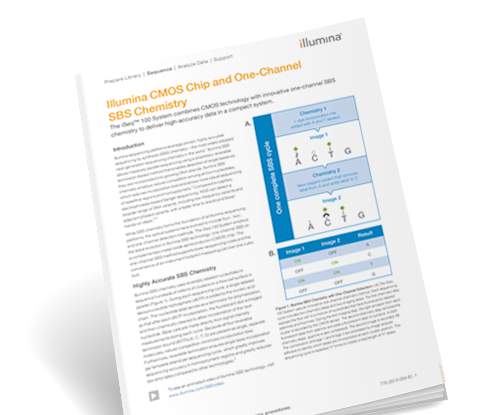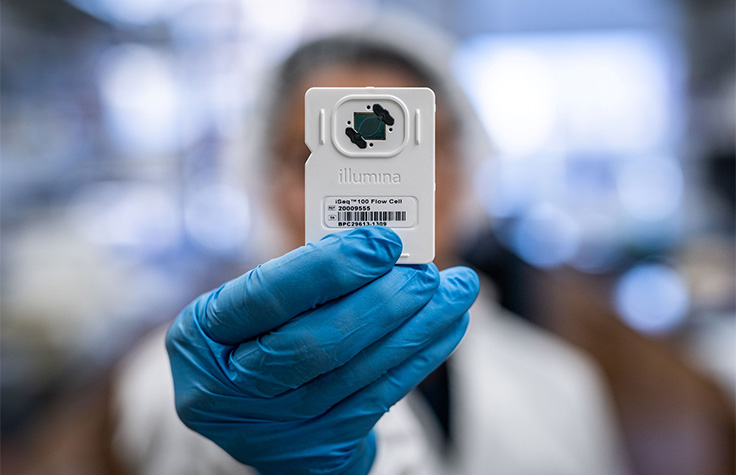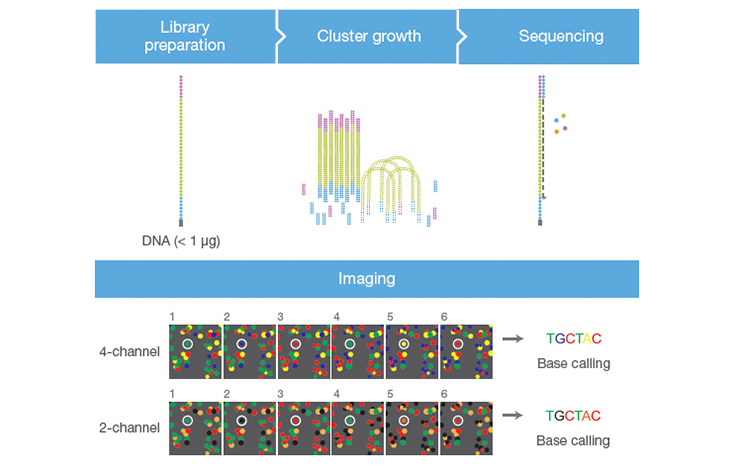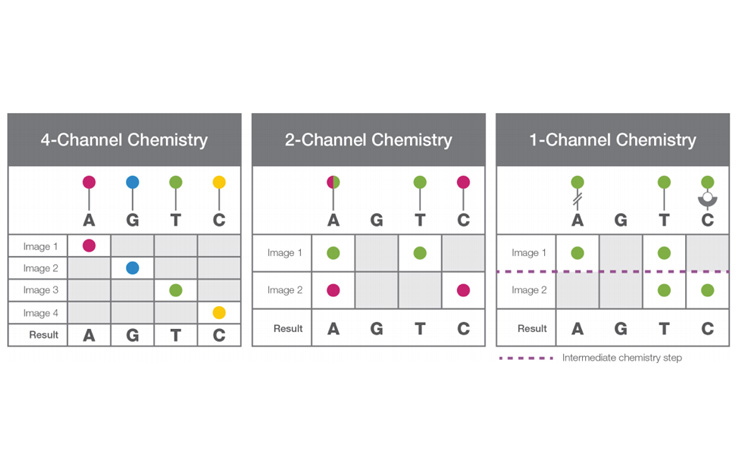2-Channel SBS Technology
Evolution of 2-Channel SBS Technology
All Illumina sequencing systems use our proven sequencing by synthesis (SBS) technology. SBS is a widely adopted next-generation sequencing (NGS) technology and delivers highly accurate base-by-base sequencing and robust performance across the genome.
Several Illumina instruments use an evolution of SBS technology known as 2-channel SBS. This method enables faster data generation with the same high data accuracy as the original Illumina 4-channel SBS technology.
Faster Sequencing and Data Processing Times
The 2-channel SBS method requires only 2 images per cycle, instead of 4 (Figure 1). This accelerates sequencing and data processing times, while delivering the same quality and accuracy that sets Illumina systems apart. These advances make 2-channel SBS an affordable solution, enabling NGS to become an everyday tool in laboratories worldwide.
How 2-Channel SBS Simplifies Nucleotide Detection
Rather than using a separate dye for each base, 2-channel SBS simplifies nucleotide detection by using two fluorescent dyes and two images to determine all four base calls. Images are taken of each DNA cluster using two different wavelength filter bands to distinguish nucleotide identity.
For example, when using an Illumina 2-channel sequencing system that leverages red and green dyes, clusters seen in red or green images are interpreted as C and T bases, respectively. Clusters observed in both red and green are flagged as A bases, while unlabeled clusters are identified as G. Illumina has many 2-channel sequencing systems, and the fluorescent dye-to-base color combinations can vary across systems.

SBS Technology Spotlight
While SBS chemistry forms the foundation of all Illumina sequencers, the optical systems have evolved to include multiple detection methods. Learn more about how 2-channel SBS compares to 1-channel and 4-channel SBS, and view quality score data.
Read Technical Note2-Channel vs. Other SBS Chemistries
2-channel chemistry uses two different fluorescent dyes. In contrast, 4-channel chemistry uses a mixture of nucleotides labeled with four different fluorescent dyes. while 1-channel chemistry uses only one dye. Images are processed by an image analysis software to determine nucleotide identity.
Selected publications featuring Illumina 2-Channel SBS Instruments
- Genotypic Characterisation and Antimicrobial Resistance of Extended-Spectrum β-Lactamase-Producing Escherichia coli in Humans, Animals, and the Environment from Lusaka, Zambia: Public Health Implications and One Health Surveillance. Kasanga M, Gajdács M, Muleya W, et al. Antibiotics (Basel). 2024 Oct 10;13(10):951.
- Data on whole genome resequencing of selected Malaysian rice accessions with opposing response to salinity stress. Ab Razak S, Zainal-Abidin RA, Mohd Ikmal A, et al. Data Brief. 2024 Oct 18;57:111051.
- Whole-genome sequence of Bacillus paralicheniformis strain R243 isolated from rice (Oryza sativa L.) roots. Chebotar VK, Gancheva MS, Keleinikova OV, et al. Microbiol Resour Announc. 2024 Nov 12;13(11):e0087924.
Advancing Malaria Research with NGS
Researchers use Illumina NGS systems, including a 2-channel instrument, to expose vulnerabilities in a malaria parasite's reproductive mechanisms.
Read InterviewFeatured 2-Channel SBS Instruments
The MiSeq i100 and MiSeq i100 Plus Systems make NGS easy for novice and experienced users with simple operations and our fastest run times.
The NextSeq 1000 and NextSeq 2000 systems offer cost-efficient flexibility for new and emerging applications.
The NovaSeq X and NovaSeq X Plus systems are our most powerful and most sustainable sequencing systems yet for extraordinary throughput and accuracy.
Find the Right Sequencing Instrument
Compare our benchtop and production-scale sequencers and find the right system for your needs.
Compare NGS Platforms
1-Channel SBS
1-channel SBS couples sequencing by synthesis chemistry with complementary metal-oxide semiconductor (CMOS) technology. While it uses the same base-calling architecture as 2-channel SBS, the 1-channel method supports lower instrument costs and the convenience of a small instrument footprint, all while maintaining high accuracy. Our smallest sequencer, the iSeq 100 System, uses 1-channel SBS.



